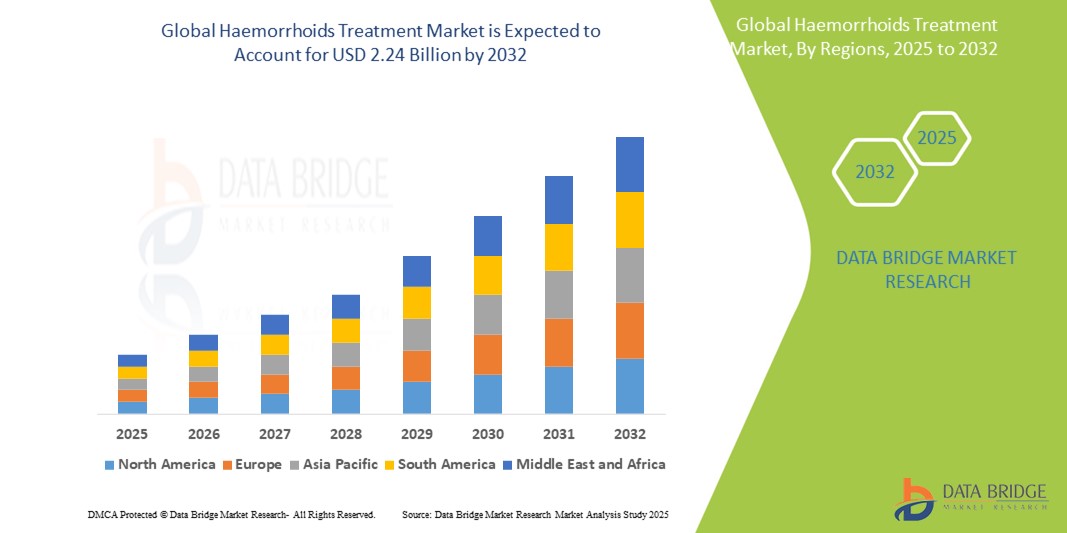Overview
Haemorrhoids, commonly referred to as piles, are swollen and inflamed veins in the rectum and anus that cause discomfort, bleeding, and itching. The increasing prevalence of this condition globally, along with greater awareness and availability of treatments, is driving the growth of the haemorrhoids treatment market.
In 2024, the global haemorrhoids treatment market is estimated to be valued at approximately USD 900 million to USD 1.2 billion, with projections indicating it could surpass USD 2 billion by 2032, registering a compound annual growth rate (CAGR) of 6% to 9%.
Source – https://www.databridgemarketresearch.com/reports/global-hemorrhoids-treatment-market
Market Drivers
1. Rising Prevalence of Sedentary Lifestyles and Poor Diet
Urbanization and sedentary work environments have contributed to poor dietary habits and constipation—primary risk factors for haemorrhoids. Aging populations and obesity further fuel this trend.
2. Growing Awareness and Willingness to Seek Treatment
Social awareness campaigns and greater health literacy are leading patients to pursue medical help for what was once considered an embarrassing condition.
3. Advancement in Minimally Invasive Procedures
Innovative procedures such as rubber band ligation, infrared coagulation, sclerotherapy, and laser therapy are reducing recovery time and side effects, boosting patient preference and demand.
4. Availability of OTC Products
A wide variety of over-the-counter creams, ointments, suppositories, and wipes offer temporary relief, driving retail market growth. These products serve as first-line therapies for mild cases and are widely adopted.
Treatment Segmentation
1. Non-Surgical Treatments
- Topical Ointments and Creams: Contain corticosteroids or pain relievers.
- Suppositories: Used to reduce inflammation internally.
- Dietary Supplements: Fiber supplements and flavonoids are often prescribed to manage symptoms.
2. Minimally Invasive Procedures
- Rubber Band Ligation (RBL): Most common office-based procedure.
- Infrared Coagulation (IRC): Uses light to cause tissue scarring and shrinkage.
- Sclerotherapy: Involves the injection of a solution to shrink the vein.
- Laser Treatment and Radiofrequency Ablation: Offer precision and faster recovery.
3. Surgical Treatments
- Hemorrhoidectomy: Surgical removal of severe or recurrent haemorrhoids.
- Stapled Hemorrhoidopexy: Less painful than traditional surgery and offers quicker recovery.
Market Segmentation by Type
- Internal Haemorrhoids
- External Haemorrhoids
- Mixed Type (Internal + External)
Each type requires a tailored treatment approach depending on the severity of symptoms and the patient’s health condition.
End-User Segmentation
- Hospitals and Clinics: Preferred for advanced or surgical treatments.
- Ambulatory Surgical Centers (ASCs): Offer cost-effective, outpatient solutions.
- Retail Pharmacies and Online Stores: Dominate the OTC market.
- Home Care Settings: A growing trend, especially in high-income countries.
Regional Analysis
North America
- Largest market share due to advanced healthcare infrastructure and high awareness.
- Increasing demand for minimally invasive procedures.
Europe
- Strong demand for both prescription and OTC treatments.
- Aging population contributes to market expansion.
Asia-Pacific
- Fastest-growing region due to rising disposable income and increasing healthcare access.
- Cultural stigma is gradually decreasing, encouraging more people to seek care.
Middle East & Africa / Latin America
- Market is growing slowly but steadily as access to healthcare improves.
Key Market Challenges
- Social Stigma: In some cultures, embarrassment delays diagnosis and treatment.
- High Costs of Surgical Treatments: In regions with limited insurance coverage, cost remains a barrier.
- Lack of Standardized Guidelines: Treatment varies significantly across regions and practitioners.
Emerging Trends
- Digital Consultations: Telemedicine is making it easier for patients to seek help discreetly.
- Natural and Herbal Remedies: Growing consumer preference for plant-based formulations.
- Technological Innovations: Development of precision laser and radiofrequency devices for enhanced safety and outcomes.
Competitive Landscape
The market is moderately fragmented. Key players focus on:
- Launching new non-invasive treatment options.
- Expanding product portfolios for OTC relief.
- Increasing regional presence through partnerships and distribution networks.
Examples of product categories include:
- Anti-inflammatory creams
- Hemostatic gels
- Anorectal cushions
- Post-surgical care kits
Market Forecast (2024–2032)
| Metric | Value |
|---|---|
| Market Size (2024) | USD 900 million – USD 1.2 billion |
| Market Size (2032) | Over USD 2 billion |
| CAGR | 6% – 9% |
| Fastest Growing Region | Asia-Pacific |
| Largest Region | North America |
| Most Common Treatment | Rubber Band Ligation |
| Leading OTC Segment | Topical ointments and suppositories |
Conclusion
The haemorrhoids treatment market is witnessing significant transformation, driven by medical advancements, increasing awareness, and rising demand for both over-the-counter and minimally invasive options. As social taboos decrease and healthcare access improves worldwide, the market is expected to grow steadily over the next decade. Manufacturers and healthcare providers focusing on affordable, discreet, and effective treatment options will be best positioned to capitalize on this growth.



